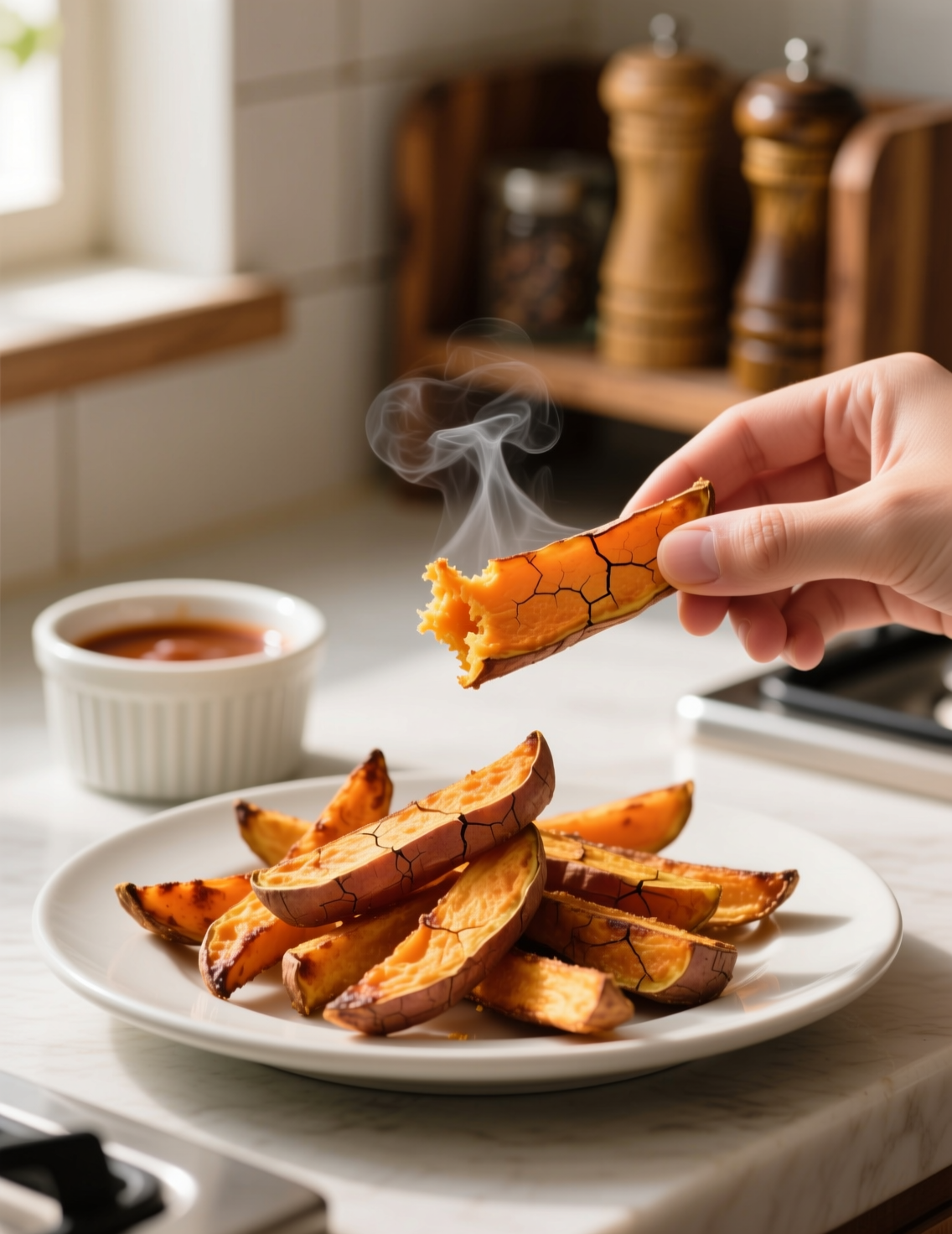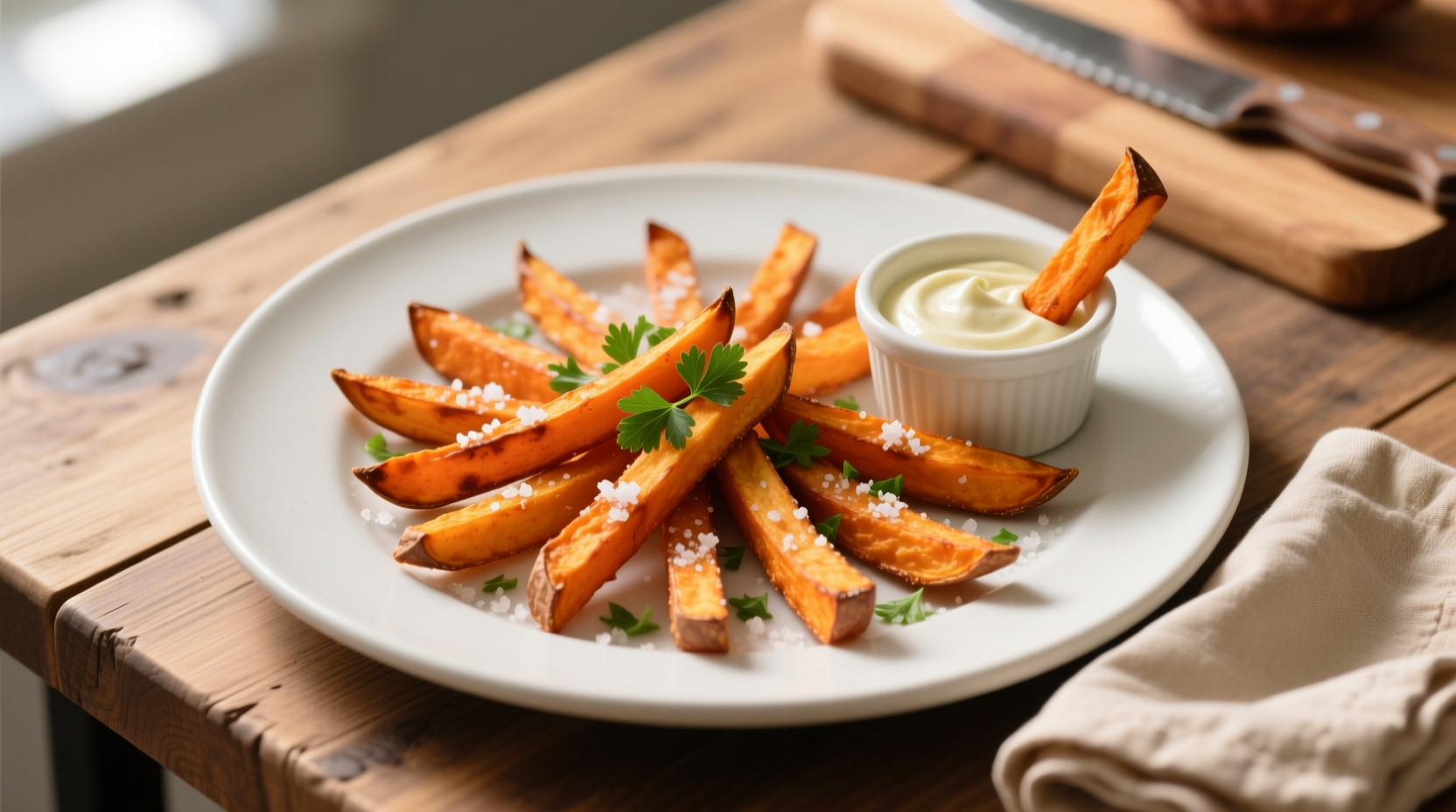Sweet potatoes aren’t just another vegetable. They sit in that strange place between indulgence and nutrition. A plate of fries that happens to be packed with fiber, beta-carotene, and a sweet edge you won’t get from russets. Today, we’re taking those orange beauties and turning them into 15-minute air fryer sweet potato fries for four. No soggy strips, no oven waiting an eternity. Just crisp, golden, fast.
Why Air Fryer Sweet Potato Fries Deserve Attention
Professional kitchens are still a bit divided on the air fryer. Some chefs see it as a toy, others as a lifesaver. But one thing is clear: the technology works. Air fryers use rapid hot air circulation, essentially mimicking convection but in a tighter chamber. That means faster cooking times and a crisp exterior with minimal oil.
Sweet potatoes, with their higher sugar content, often burn in deep fryers if the oil isn’t carefully managed. In the air fryer, though, you can dial in the balance—soft inside, crunchy edges, a caramelized sweetness that doesn’t turn bitter. In 15 minutes, you’ve got a side dish that plays well with roasted chicken, sliders, or even a quick grain bowl.
The Nutritional Edge
It’s worth pausing on the nutrition. A single medium sweet potato provides about 400% of the daily requirement for Vitamin A, according to USDA data. Frying in oil usually robs food of its “health halo,” but an air fryer only needs a tablespoon at most. That translates to fewer calories and less saturated fat while keeping those nutrients intact.
For dietitians working with clients, air fryer fries have become an easy swap. A study published in Food Chemistry in 2021 noted that air frying preserved antioxidants better than deep frying. That’s one of those rare win-win cases: flavor and nutrition co-existing without compromise.
Ingredients You’ll Need
For 4 servings, here’s the precise breakdown that makes these fries reliable:
- 2 large sweet potatoes (about 1 ½ pounds total)
- 1 tablespoon olive oil (or avocado oil for higher smoke point)
- ½ teaspoon smoked paprika
- ½ teaspoon garlic powder
- ½ teaspoon salt (plus more to finish)
- ¼ teaspoon black pepper
Optional but smart: ½ teaspoon cornstarch. It helps create that elusive crisp, coating the fries in a whisper-thin shell. Professionals often use starch in batters for exactly this reason.

Step-by-Step Cooking Method
- Prep the potatoes. Peel them if you prefer a cleaner look, though many chefs keep the skins for texture and nutrients. Slice into even sticks—about ¼ inch thick. Uneven cuts lead to uneven cooking.
- Soak briefly. A 15-minute soak in cold water draws out excess starch. This prevents the fries from clumping and improves crispness. Drain and pat completely dry with a towel. Moisture is the enemy of browning.
- Season. Toss the fries with olive oil, paprika, garlic powder, salt, pepper, and cornstarch if using. Make sure every fry is coated, but not swimming.
- Load the air fryer. Spread fries in a single layer. Crowding them leads to steaming, not crisping. Cook in two batches if needed.
- Cook. Set air fryer to 400°F (200°C). Cook for 12–15 minutes, shaking the basket halfway. Thinner fries will finish closer to 12 minutes, thicker ones nearer to 15.
- Finish. Taste, add a sprinkle of salt, maybe even fresh parsley or a squeeze of lime for brightness. Serve immediately while hot.
The Science Behind Crispness
Crisp fries aren’t magic. They’re physics. When sweet potato strips hit 400°F air, surface water evaporates quickly. The starch granules at the surface gelatinize, forming a rigid structure. Oil aids by creating an even distribution of heat, preventing spots that would stay soft.
The cornstarch trick adds another layer. It absorbs surface moisture and turns into a crisp shell when exposed to hot air. That’s the same science behind tempura batters—light starch films that trap bubbles and crunch.
Common Mistakes (And How to Fix Them)
Many first-timers complain about soggy fries. Usually, it’s one of three culprits:
- Overcrowding. Fries need space. If they’re piled, steam gets trapped, and you get limp strips. Cook in batches.
- Skipping the soak. Removing surface starch sounds optional, but it changes everything. Without soaking, fries stick and brown unevenly.
- Too much oil. A tablespoon is enough. More, and fries turn greasy. Less, and they dry out. Balance matters.
Another common issue is burning tips. This happens because of the natural sugars in sweet potatoes. Reducing the cooking temperature slightly (to 380°F) for the last few minutes can save them if you notice over-browning.
Flavor Variations Worth Trying
This recipe works as a base, but chefs rarely leave well enough alone. Here are a few professional-level twists:
- Spicy Cajun. Add cayenne, onion powder, and oregano to the mix. Perfect with grilled meats.
- Parmesan Herb. Toss finished fries with grated Parmesan and chopped rosemary or thyme. A sharp, savory note against the sweet base.
- Maple Chili. A drizzle of maple syrup and chili flakes right after cooking. The heat and sweet combo is addictive.
- Za’atar Blend. Middle Eastern spices like sumac, sesame, and thyme turn fries into a mezze-friendly side.
Chefs often say fries are just a canvas. The seasoning defines the experience.
Pairings That Work
Sweet potato fries lean sweet, so balance them with acidity, fat, or umami. Aiolis—garlic, chipotle, or lemon—are classics. Yogurt dips with herbs like dill or mint cut through the richness. For main dishes, think roasted salmon, turkey burgers, or even a grain salad topped with feta.
In restaurants, you’ll often see them paired with sliders or sandwiches because the contrasting textures and flavors create balance on the plate. It’s that interplay of crunchy-soft, sweet-savory, light-heavy.
A Professional’s Perspective on Air Fryer Efficiency
Commercial kitchens rarely use domestic air fryers, but the principle is catching on in professional combi ovens and convection systems. Energy efficiency is one reason. Air frying uses up to 70% less energy compared to deep frying, according to Energy Star data.
For smaller operations or food trucks, air fryers can mean lower oil costs, less waste, and faster turnover. And importantly, no giant vats of hot oil to manage. That safety factor alone makes them appealing.
Sweet Potatoes in Culinary History
It’s easy to forget this tuber has traveled the world. Originating in Central and South America, sweet potatoes were brought to Europe by Christopher Columbus. Today, they’re cultivated in Asia, Africa, and the U.S. North Carolina alone produces over 60% of America’s supply, USDA reports show.
Different regions bring different varieties: Japanese satsumaimo with their purple skin and chestnut-like flavor, or the cream-fleshed boniato popular in Caribbean cuisine. All can be air fried, though textures vary slightly.
Addressing Misconceptions
There’s a myth floating around that sweet potato fries are automatically healthier than regular fries. Truth? They’re different, not necessarily healthier. They have more fiber and Vitamin A but also slightly more sugar and sometimes more calories depending on portion.
Another misconception is that air fryers eliminate oil entirely. That’s not accurate. A little oil is crucial for flavor and browning. Think of air frying as oil-efficient, not oil-free.
Trends and Consumer Appeal
Google Trends shows a sharp rise in “air fryer recipes” over the last three years. Millennials and Gen Z especially have adopted them for convenience. Sweet potato fries sit at the intersection of comfort food and health-conscious eating. Restaurants know this—menus increasingly highlight “air-fried” options to signal better nutrition without compromising flavor.
Social media also plays its part. Bright orange fries photograph beautifully against dark plates or wooden boards. Food stylists lean on that visual pop, making them ideal for Instagram spreads.
Expert Tips for Scaling Up
Cooking for four is easy. Cooking for 40 is different. In larger batches, preheat the air fryer fully before each load. Rotate baskets if using multiple units. Season fries after cooking in bulk, otherwise spices burn. For catering, hold cooked fries in a warm oven at 200°F, uncovered, to maintain crispness.
Some chefs even par-cook fries earlier in the day, chilling them, then finishing in the air fryer to save time during service. That two-step process boosts crispness, not unlike the double-fry method used in French fry shops.
Final Thoughts
Fifteen minutes isn’t much time, yet with an air fryer, it’s enough to turn sweet potatoes into something crave-worthy. The method is precise, the result consistent, and the nutrition strong.
Professionals see value in dishes that are versatile, quick, and visually striking. Air fryer sweet potato fries check all three boxes. Whether you serve them with a simple garlic aioli or pile them alongside sliders, they deliver.
Next time someone tells you fries can’t be healthy, point them toward a basket of these golden-orange strips. They might change their mind after one bite.
FAQs
Can I make these sweet potato fries without oil?
Yes, but a little oil helps them crisp and taste better.
Do I need to peel the sweet potatoes?
No, the skin adds texture and nutrients, but you can peel if you prefer.
Why should I soak the fries before air frying?
Soaking removes excess starch, which makes the fries crispier.
What temperature should I set the air fryer to?
400°F (200°C) works best for even browning and crunch.
How long does it take to cook sweet potato fries in the air fryer?
About 12–15 minutes depending on thickness.
Can I cook them all at once if I have a large batch?
Not recommended, cook in batches to avoid soggy fries.
How do I keep fries from sticking together?
Dry them well after soaking and coat lightly with oil or cornstarch.
What seasonings go well with sweet potato fries?
Smoked paprika, garlic, Cajun spice, Parmesan, or even maple chili.
Are air fryer sweet potato fries healthier than deep-fried ones?
Yes, they use less oil and retain more nutrients.
Can I reheat leftover sweet potato fries?
Yes, reheat in the air fryer at 375°F for 3–4 minutes until crisp again.

Mariana is a passionate home cook who creates delicious, easy-to-follow recipes for busy people. From energizing breakfasts to satisfying dinners and indulgent desserts, her dishes are designed to fuel both your body and hustle.
When she’s not in the kitchen, she’s exploring new flavors and dreaming up her next recipe to share with the Foodie Hustle community.

